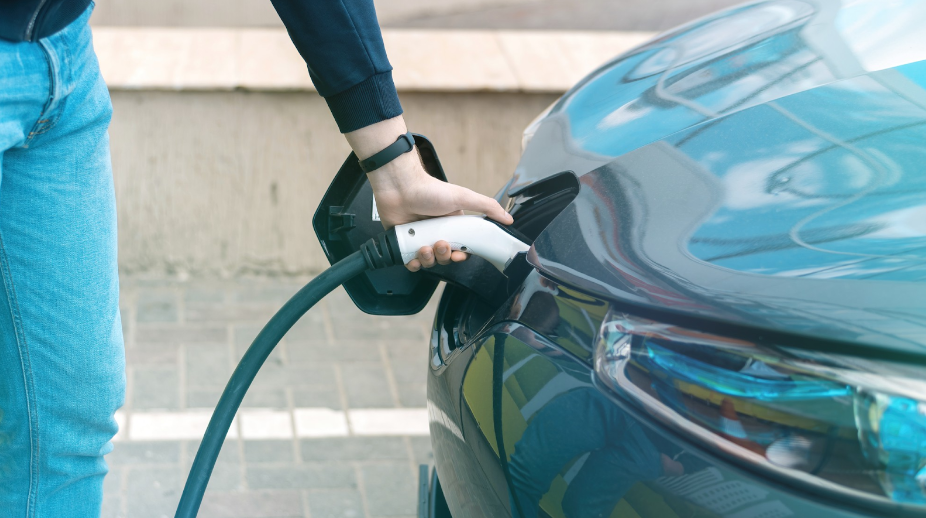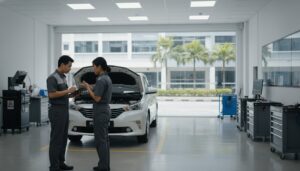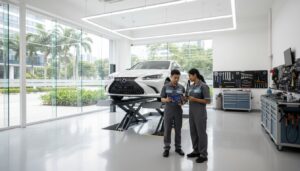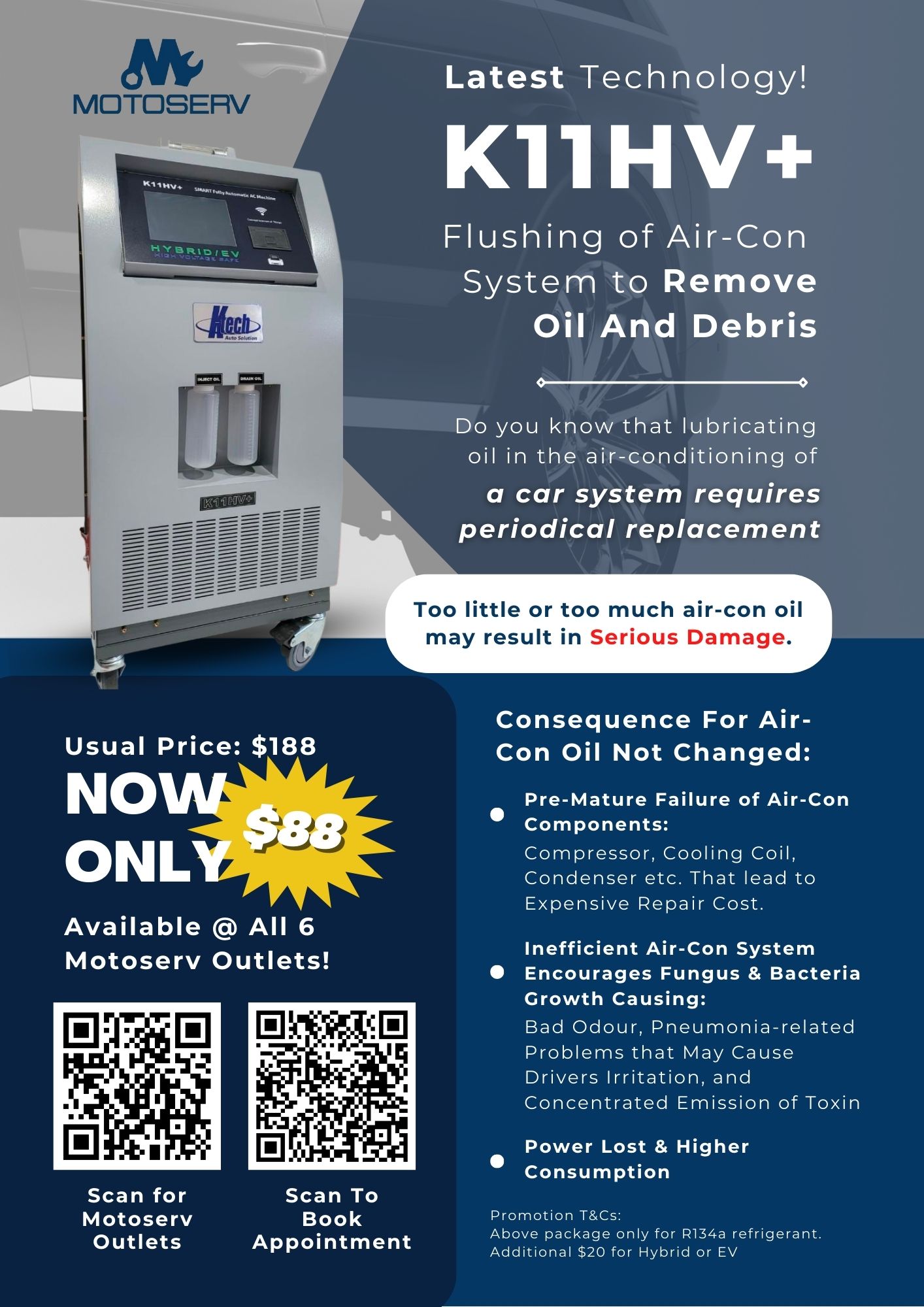As transportation remains essential in our daily lives, the long-standing reliance on internal combustion engines (ICE) has contributed significantly to environmental degradation through greenhouse gas emissions.
In response, car manufacturers and governments worldwide are seeking cleaner, more efficient alternatives. In Singapore, this shift is evident as the government and the Land Transport Authority (LTA) plan to phase out ICE vehicles by 2040, promoting carbon-neutral mobility.
In this article, we will delve into the world of hybrid vehicles, exploring what defines them, the various types available, and the crucial importance of maintaining a hybrid battery.
We’ll also address some frequently asked questions to provide a comprehensive understanding of hybrids.
What are Hybrids?
Now, hybrid cars are similar to conventional ICE vehicles in that hybrid car services are just as important as they are for any traditional ICE cars.
The main difference is that hybrids are supported by an electric motor. This combination brings numerous benefits including enhanced fuel efficiency and a quieter driving experience.
Additionally, hybrids also contain regenerative braking as a means to restore kinetic energy to electricity.
Just to be clear, Battery Electric Vehicles (BEVs) are not hybrids. These vehicles rely solely on electric motors for movement and are fully dependent on electricity.
Types of Hybrids Vehicles
Car manufacturers have dabbled on a variety of hybrid variants, but the three types that are commonly used today are Hybrid Electric Vehicles and Plug-In Hybrids.
Each of these has its own advantages. Here’s a breakdown of each type and its respective benefits:
Hybrid Electric Vehicle
Hybrid Electric Vehicles, or HEVs, work in conjunction with the engine to enhance fuel efficiency.
HEVs can power the car alone at low speeds and improve efficiency over longer distances. However, their motors are not designed for long distance electric travel, due to how small the motor is. An example of a Hybrid Electric Vehicle is the Toyota Prius.
Plug-In Hybrid
Plug-In Hybrid Electric Vehicle (PHEV), or simply just Plug-In Hybrid allows the vehicle to be charged from an external power source. Compared to HEVs, PHEVs can travel exclusively on electric alone for longer distances.
PHEVs typically have a larger battery than HEVs, enabling them to offer a more substantial electric-only driving range before the engine kicks in. An example of a PHEV is the Mazda CX90.
Environmentally, PHEVs can reduce their impact if they are charged regularly, as using the electric-only drive mode consistently has a minimal effect on the environment.
Types of Hybrid Car Batteries
Nickel-Metal Hydride (NiMH)
Nickel-Metal Hydride (NiMH) batteries were widely used back in earlier generations of hybrid cars.
Compared to lithium-ion, NiMH batteries are generally easier and less expensive to manufacture due to their simpler design and lower production costs.
NiMH batteries are also cheaper because the rare earth materials used cost less than high-purity lithium.
Lithium-ion (Li-ion)
Thanks to the constant research and development, lithium-ions are becoming common in modern hybrids, including PHEVs as Li-Ion batteries have a high energy density, meaning they can store more energy in a smaller and lighter package.
Compared to NiMH, these batteries are more efficient in charging and discharging, which leads to better fuel economy while being able to generate less heat, which reduces the need for complex cooling systems.
How Do They Work?
Regenerative Braking & Charging Stations
Now that we know what hybrids are, it’s important to understand how they work. One key component is regenerative braking.
Regenerative braking is a fundamental component in hybrid vehicles, it improves efficiency by converting kinetic energy into electrical energy during braking.
Here’s a breakdown of how it works:
Energy Conversion
Normally, when a car slows down, the brakes would turn the kinetic energy into heat.
This applies to hybrids as well, but during the conversion, electric motor acts as a generator and converts the kinetic energy into electrical energy
Energy Storage
The electrical energy would then be stored in the vehicle’s hybrid battery.
This stored energy can later be used to power the electric motor, reducing the need to use the internal combustion engine and thereby saving fuel.
Regenerative braking shines the most in situations like where there are frequent brakes like during a stop and go traffic or city driving.
It helps improve the overall efficiency of a hybrid vehicle by capturing energy that would otherwise be lost.
Plug-in Chargers for Hybrids
We know that PHEVs have larger batteries than regular hybrids because it is needed in order for the battery to be recharged from an external power source. Here’s how plug-in chargers work:
External Charging
PHEVs can be charged by plugging them into an external power source, such as a home outlet or a public charging station. These two have a few differences between them. In short:
Home Charging
Most homeowners use a standard 120-volt (Level 1) or 240-volt (Level 2) charger. These typically take several hours to fully charge the battery.
Public Charging
Public charging stations usually offer Level 2 charging, with some providing even faster options (Level 3 or DC fast charging), which can charge the battery in less than an hour.
This external charging allows the larger battery in a PHEV to power the vehicle in all-electric mode for a certain distance before the internal combustion engine takes over or assists.
Similarly like HEVs, PHEVs also use regenerative braking to recharge to help recharge the battery.
With both combined, PHEVs to maximize efficiency, reduce fuel consumption, and lower emissions.
Tips On Maintaining A Hybrid Battery
In Southeast Asia, we’re known for being one of the hottest places to be all year round. Just this year, we’ve experienced one of the hottest days on record due to a climate phenomenon known as El Nino.
So, maintaining a hybrid battery in hot climates like Singapore is crucial for ensuring longevity and efficiency. Here are some tips to help you manage your hybrid battery, especially during the heat:
Park Indoors or In Shaded Areas
Whenever possible, park your hybrid vehicle indoors, or in shaded areas. If this isn’t possible, try using a sunshade.
This is to reduce the overall temperature inside the car, preventing it from overheating as constant exposure to high temperatures can degrade the battery.
Avoid Rapid Charging During Hot Days
If you drive a plug-in hybrid, it’s best to avoid rapid charging during the hottest parts of the day. Since rapid charging generates heat, also adding with the high ambient temperatures, this can stress the battery.
Charging during the cooler times, such as during the evening or at night, or in well-ventilated areas, can help mitigate this.
Routine Maintenance
It goes without saying that doing routine maintenance on your car should be a priority. It is recommended to have your hybrid car battery checked annually or approximately every 20,000 km. This helps identify potential issues early before they become serious.
Note that hybrid battery maintenance should be performed by a professional, as it can be hazardous. At Motoserv, we specialize in servicing hybrid car batteries.
Monitor Battery Health Regularly
Many modern hybrid cars come with diagnostic tools that allow you to monitor the health of your battery.
Regularly check the battery’s performance and consult with a service provider if you notice any decline in efficiency or frequent need for charging.
Regular Maintenance and Cooling System Checks
Hybrid vehicles often have a dedicated cooling system for the battery. Most will display a notification on the MFD (Multi-Function Display) when servicing is required.
If this is the case, contact a specialist or better yet, prevent this from happening by regularly servicing your car. A simple self-maintaining can also be done by checking for any blockages in the air vents and ensuring that the coolant levels are adequate.
In Singapore, it is recommended to have the inverter and radiator coolant flushed and replaced every 60,000 km.
If you are looking for a place to service your hybrid cars and have it checked out by professionals, contact us or call +65 6259 1518
Frequently Asked Questions (FAQ)
How long does a hybrid car battery last?
In Singapore, the lifespan of a hybrid car battery typically ranges from 6 to 10 years, depending on usage and maintenance.
Regular maintenance, such as servicing every 12 months or every 40,000 kilometers, can help prolong the battery’s life.
How Much Does It Cost To Replace A Hybrid Car Battery?
When it comes to replacement costs, these can vary significantly based on the make and model of the vehicle. The cost of replacing a hybrid car battery in Singapore generally falls between SGD 2,000 and SGD 10,000.
This range accounts for different battery types and whether you opt for an original equipment manufacturer (OEM) battery or a refurbished one.
Is There A Warranty For Hybrid Car Batteries?
The warranty period for hybrid car batteries generally ranges from 8 to 10 years or 150,000 to 200,000 kilometers, whichever comes first. Some manufacturers offer extended warranties.
This warranty usually covers defects in materials or workmanship but may not cover issues arising from misuse or lack of proper maintenance
What Should I Do If My Hybrid Car Battery Is Losing Power?
If you notice a decrease in battery performance, it’s important to have the battery checked by a qualified technician.
In Singapore, many dealerships and service centers offer battery diagnostics and replacements.
Can I Drive A Hybrid Car If The Battery Is Completely Dead?
Most hybrid vehicles have a backup internal combustion engine that can still operate the car if the battery is depleted, but it’s important to have the battery checked and repaired as soon as possible to maintain optimal performance.
Are Hybrid Car Batteries Environmentally Friendly?
While hybrid batteries are designed to be recyclable and are less harmful than traditional car batteries, their disposal and recycling do require careful handling to minimize environmental impact.
How Does Singapore’s Climate Affect Hybrid Car Batteries?
Singapore’s hot and humid climate can affect the longevity of hybrid car batteries. Proper maintenance and keeping the battery cool can help mitigate adverse effects.








